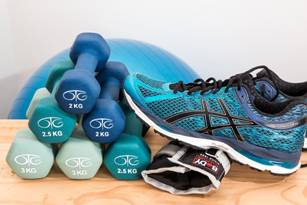What Are the Best Forms of Exercise for COPD Patients?
Although exercise cannot reverse chronic obstructive pulmonary disease (COPD), it is key to effectively manage the condition and enhance overall health. Despite the prevalence of lung damage that leads to COPD, exercise can also help to avoid deterioration of the condition that can result in increased breathlessness and a worsening prognosis.
 A study published in the Annals of the American Thoracic Society reveals the “association between physical activity levels and hospitalizations among a large group of COPD patients.” The results showed that patients who participated in any level of consistent moderate to vigorous physical activity had a profoundly lower risk of 30-day hospital readmission.
A study published in the Annals of the American Thoracic Society reveals the “association between physical activity levels and hospitalizations among a large group of COPD patients.” The results showed that patients who participated in any level of consistent moderate to vigorous physical activity had a profoundly lower risk of 30-day hospital readmission.
Researchers noted that physical inactivity reflects a worsened state of the disease, and the results support the theory that “promoting and supporting physical activity is a promising strategy not only to reduce the risk of having the [initial] hospitalization but also to buffer the stresses of hospitalization…Our findings further support the importance of physical activity in the overall management of COPD across the care continuum, including care transition efforts to reduce 30-day readmissions.”
The following steps highlight the most beneficial exercises for COPD patients and how they can incorporate them into their daily routine.
Get Checked Out
It is essential for COPD patients to first speak with their doctor before beginning any exercise routine to ensure they can safely increase their levels of physical activity. As part of COPD management protocol, doctors will often prescribe a pulmonary rehabilitation program which can help patients learn the most effective exercises and how to accurately perform them.
Stretching and Relaxation
Stretching is an optimal practice to begin before an exercise session, as it can help to loosen muscles and prevent an injury from occurring. For COPD patients in particular, “loosening up the muscles around the neck, chest and upper back may offer more room for the lungs to expand,” effectively enabling individuals to breathe easier.
Additionally, practicing yoga or tai chi can help to loosen muscles and encourage relaxation. Finding effective stress reduction techniques is essential as COPD can induce anxiety due to breathing complications and worsen symptoms. Both pursed-lip and diaphragmatic breathing are effective techniques to help patients relax, since they can help to “reduce some of the hyperinflation of the lungs that can result from COPD.”
Strengthening
COPD patients can also benefit from strengthening exercises for both the upper and lower body, such as lifting light free weights, and using weight machines or stretchy resistance bands. Lower body resistance exercises may also incorporate “side leg lifts, heel-to-toe lifts and repetitions of rising from seated to standing positions.”
Upper Extremity Endurance
Improving and maintaining both upper extremity strength and endurance is essential, so patients can remain independent. Upper extremity endurance includes the ability to reach for items on high shelves or dress themselves. To build upper body endurance, many patients utilize an arm ergometer – “a small, tabletop bicycle that’s pedaled with the arms.” If patients don’t have access to this machine, they can also use resistance bands or practice arm exercises to facilitate upper extremity strength.
Lower Body Endurance
Lower body endurance exercises, such as walking and cycling, are recognized as the “cornerstone” of a pulmonary rehabilitation program and are essential for COPD patients to regularly practice. Without this endurance, patients are more likely to experience difficulty in completing daily tasks. Depending on the stage of their COPD, patients can also benefit from incorporating water aerobics and swimming into their exercise regimen.
Start Slowly and Build Gradually
It’s also important to note that if a patient has been mostly inactive for a significant period of time, they should steadily ease back into a regular exercise routine and build gradually allowing the body to adjust. Choosing an activity that is enjoyable can also help to create a long-term lifestyle change.
Click Here to Access the Full Article on U.S. News & World Report

